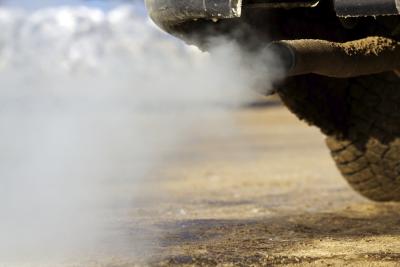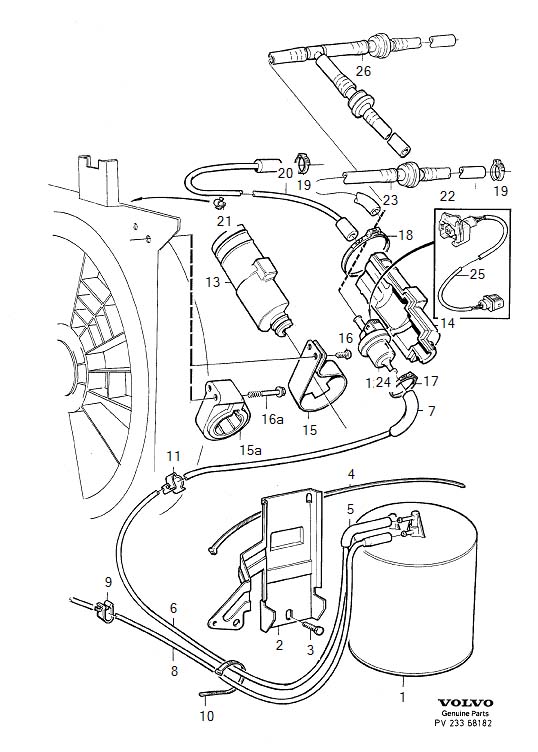 Modern cars have advanced to the point where the much of the concern of pollution is no longer from the tailpipe - modern emissions controls such as catalytic converters, secondary air pumps, and advanced engine control units have advanced emissions control to the point that in some cases, the exhaust coming out of the tailpipe is cleaner than the air going into the engine.
Modern cars have advanced to the point where the much of the concern of pollution is no longer from the tailpipe - modern emissions controls such as catalytic converters, secondary air pumps, and advanced engine control units have advanced emissions control to the point that in some cases, the exhaust coming out of the tailpipe is cleaner than the air going into the engine.
Vapors are stored and burned
However, the emissions from the tailpipe are only one of many emissions that the car has to control. One of the big ones addressed in this article is the Evaporative Emissions Control System. This system was introduced in 1971 and is designed to prevent evaporating fuel vapors from escaping into the atmosphere - usually by storing the vapors and then burning them in the engine at a controlled rate.
Gasoline fuel vapors are a main contributor to photochemical smog - smog generated when pollutants react with light to produce harmful secondary pollutants which can have an adverse affect on the people affected by the smog cover by exacerbating conditions such as asthma. Children and the elderly are also especially at risk with heightened smog exposure.
Systems are controlled by the ECU
What exactly is the evaporative emissions portion of the emissions control system? These systems deals with fuel and fuel vapor emissions from the fuel tank and fuel lines and includes the fuel cap, the fuel lines running to the engine, purge valves and solenoids, and a charcoal canister that has activated carbon. All of the systems are carefully controlled by the engine control computer.
The car would have a gassy smell
During normal operation, the fuel tank is filled by the fuel filler neck and the fuel is stored in the fuel tank. The fuel filler neck has a series of valves and flaps that allow fuel in, but does not allow fuel vapors to go back out. When the fuel heats up and begins to vaporize, such as when the car is parked in the sun, the fuel tank needs to vent excess vapor to prevent a buildup of pressure. Traditionally on pre-emissions control cars, the fuel tank was vented directly to the atmosphere and the car would have a distinct gassy smell. However, on emissions-controlled cars the fuel tank vents into a canister filled with activated charcoal - the activated charcoal absorbs the fuel vapors and contains them, preventing the buildup of pressure in the fuel tank and preventing them from being vented to the atmosphere.
When the engine is running at partial throttle, such as cruising on the highway, the engine computer will activate a purge solenoid. This purge solenoid allows the vapors from the charcoal canister to be drawn back into the engine and burned. The rate at which the fuel vapors are drawn back into the engine is carefully controlled since it contains fuel and affects the air/fuel ratio of the running engine.
A leaking EVAP system can introduce vacuum leaks
Often times on older cars, the hoses and connectors that hook up the various lines may become brittle and crack, and the electrical solenoids and valves that control vapor flow can also fail. Beyond venting fuel vapors to the atmosphere, a leaking evaporative emissions system can also introduce vacuum leaks that can cause the engine to run rough and will likely throw a Check Engine Light.
Inspecting and replacing worn, cracked, and brittle lines and fittings and failed solenoids will help keep your car in compliance with emissions laws by reducing the amount of emitted fuel vapors, and also keep your car running healthy and happy.
About the Author: Andrew Peng
 Andrew is an aerospace engineer and car fanatic that enjoys working on his garage of Volvos and Subarus. When he's not busy attending car meets and shows or taking things apart, he enjoys driving his cars and finding interesting new ways to break them. He can be reached via his personal website at http://andrewpeng.net, Facebook, Google+, Instagram, or Twitter.
Andrew is an aerospace engineer and car fanatic that enjoys working on his garage of Volvos and Subarus. When he's not busy attending car meets and shows or taking things apart, he enjoys driving his cars and finding interesting new ways to break them. He can be reached via his personal website at http://andrewpeng.net, Facebook, Google+, Instagram, or Twitter.













